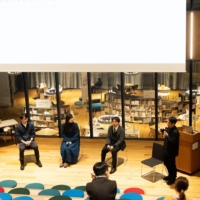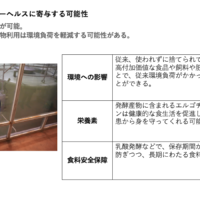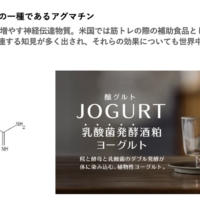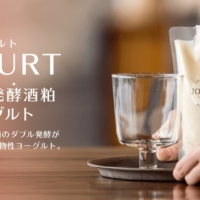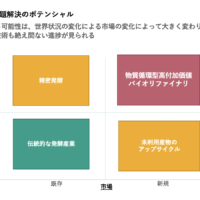From Niigata to the Universe. Paving the way to the future with the power of fermentation 'The science of fermentation in Niigata' event report.
Nagaoka City, Niigata Prefecture, has long produced sake, miso, soy sauce and other fermentation-related products. FARM8, which has operated businesses on the theme of fermentation, organised a talk event on 1 December 2023 at Nagaoka Miraie on the theme ‘The Science of Fermentation in Niigata’. The event featured a panel discussion with Euglena co-founder Kengo Suzuki, space caster Reimi Enomoto and FERMENT8 representative director Takashi Nagai.
Event overview.
Date: 1 December 2023, 18:30-20:30.
Venue: “Miraie Step”, Miraie Nagaoka, Rice Hundred Bales Place
Theme: The science of fermentation in Niigata
A talk event exploring the potential of the brewing microorganisms nurtured by Niigata’s rich nature. In the first half, Kengo Suzuki, co-founder of Euglena, spoke about the role fermentation plays in modern society and the potential of fermentation in Niigata Prefecture, and in the second half a panel discussion was held based on this content.
speaker
Kengo Suzuki, co-founder of Euglena
Reimi Enomoto, space caster.
Takashi Nagai, Representative Director, FERMENT8 Co.
moderator
Atsushi Kabasawa, Representative Director, FARM8 Inc.
・Global environmental limits. Solving environmental problems with food
Suzuki: “Today I would like to talk about the role of fermentation, but before that I would like to talk about the “Planetary Boundary” and the “Blue Zone”. Planetary Boundary is a concept that describes the range and limits of environmental activities that allow humans to live safely. The concept includes nine key processes in the global environment, each of which has a set of safe limits. If these limit values are exceeded by human activities, irreversible changes to the Earth’s environment can rapidly occur. For example, loss of biodiversity could lead to genetic depletion, a situation that could be irreversible. I believe that there are aspects of these problems that can be solved through food.”
‘Then I will talk about the Blue Zones. There are regions of the world where people live longer. These five major regions are known as the Blue Zones and have been the subject of various studies. Among the nine rules learned from the world’s 100 longest-living people is the rule that small amounts of alcohol before 5pm are good for your health. This suggests that moderate amounts of alcohol may help relieve stress, and as FARM8, we believe we can make a contribution in these areas.”
・The role of fermentation in the healthcare sector.
‘So in what ways can fermentation help with the health of the planet? ‘The use of by-products from the fermentation process has the potential to reduce environmental impact. First, from an environmental point of view, the use of by-products that would otherwise be thrown away unused can be utilised to produce high value-added foods and feeds, thereby reducing the environmental impact. Looking at nutrients, ergothioneine and polyamines may protect against some chronic diseases. Other nutrients, such as lactic acid fermentation, could be used to increase the shelf life of target foods, thus preserving food for a relatively long period of time and improving yields in food utilisation, thus enabling a relatively stable food supply.”
‘One of the nutrients that has been getting a lot of attention recently is ergothioneine. Please learn this word, as it is something that we can expect fermentation to play a role in the healthcare sector. Previously, the University of Tsukuba and Euglena analysed the livers of mice bred in the zero-gravity conditions of JAXA’s space, and it was clear that the rodents in the zero-gravity conditions had a clear decrease in sulphur compounds. The substance that showed the greatest reduction was ergothioneine. Generally, when living organisms such as humans are exposed to cosmic radiation, they undergo oxidation similar to ageing, but the presence of ergothioneine creates a movement to prevent oxidation in a way that maintains health. Ergothioneine is a nutrient that is expected to have a positive effect in our bodies.
Another one that may come next to ergothioneine is agmatine. It is a neurotransmitter that increases blood flow and is distributed as a muscle training aid in the USA. The food containing this agmatine is sake lees. From now on, I would like to carry out research on the micro-organisms in sake lees.”
・Research and development potential in fermentation.
‘Fermented foods have long been popular in Niigata Prefecture, especially in Nagaoka City. I hope to spread products that make use of these to the rest of the world. Now that logistics and the internet are in place, I think it is possible to make use of my speciality, research into micro-organisms, and communicate this to the whole country and the world through information dissemination. For example, I am also a visiting professor at Gadjah Mada University in Indonesia, and I would like to develop fermented foods in Indonesia using Japanese technology and analyse fermentation technology used independently in Indonesia in Japan. Indonesia is said to be a major producer of fermented foods, on a par with Japan.
Microbes are also attracting attention in the space industry: there are plans for 1,000 people to live on the Moon by 2040, but it is not realistic to keep sending the necessary resources from Earth. Using green beetles to convert them into nutrients, mainly enzymes and proteins, and using micro-organisms to grow vegetables even in space, could greatly improve the living environment. I personally think it would be interesting if one day we could make sake or beer on the moon.”
・Intersection of space and fermentation
Kabasawa: ‘Thank you very much. There was a lot of very deep discussion. I would like to explore this in more detail with our guests. Enomoto-san, you talked about space and fermentation, can you tell us how they are related?”
Enomoto: “Currently, a NASA-led project called the Artemis Project has begun, which aims to land humans on the Moon again in 2025. After that, there is a plan to electrolyse water, which is said to be on the moon, to use it as rocket fuel, and then to go to Mars. In this way, space development is progressing and the space business is accelerating. How Japanese traditional food is connected is its relevance as space food. Japanese food is very popular among astronauts and is also preferred by people from other countries. This means that Japanese food is also likely to become popular when 1,000 people settle on the Moon after 2040. It is important to improve the quality of life when living in space, and I think Japan, and especially Nagaoka’s food culture, can make a big contribution in that respect.”
Kabasawa: “That’s exciting – when I first started FARM8, I wanted to make Niigata’s fermentation culture better known to the people of Niigata Prefecture and the rest of Japan, but then I met Mr Suzuki and started aiming for the world, and now space. The possibilities just keep expanding.”
・The hidden potential of Niigata’s micro-organisms.
Kabasawa: “So, in relation to what you have just said, why has the brewing culture in Niigata Prefecture developed to such an extent? Mr Nagai, can you tell us about its origins and reasons?”
Nagai: “First of all, if I talk about the origins of Niigata, one reason is that Niigata has a port, so it was a place where a variety of foodstuffs could reach, and another reason is that it was a place where a lot of rice was produced. In the past, it was not easy to travel long distances, so rice production had to be regulated locally. When a lot of rice was produced, it was adjusted by making sake. It is assumed that this is how the number of sake breweries increased.”
Kabasawa: “Also, I think one of the reasons is that there are many sake drinkers. It snows a lot in Niigata. When they shovel snow, they do the same for their neighbours’ houses and have a drink to say ‘thanks’. I think the culture of helping each other has increased the number of sake drinkers. I would also like to discuss fermentation in Japan. On the other hand, I think the Western culture feeds grains to livestock and tries to get nutrients from their meat. I think that this difference in animal and plant nutrients leads to differences in health.
Suzuki: “When I think about the causal relationship between the longevity of the Japanese people and their health, I think it can be attributed to the fact that they eat a lot of fermented foods and mushrooms. I have a hypothesis that the high levels of ergothioneine and agmatine, which I mentioned earlier, are linked to longevity in comparison with other countries, and I would like to verify this from now on. Niigata has a diverse environment, so there are still a variety of micro-organisms. I think we can do even more interesting things by studying these micro-organisms and combining them.”
Kabasawa: “I think that in the past, people did not understand the relationship between micro-organisms and fermentation, but somehow they felt that delicious food was produced, and by doing science there, it may happen that this was actually a Mecca for micro-organisms. When I was touring Setsudaya (Nagaoka City) with guests today, the wife of Hoshino Honten told me that just by coating salmon with koji, the preservation of the salmon improves. But that kind of story doesn’t come out in the open. The same is true of sake lees, which has many ingredients, such as the agmatine mentioned earlier, but they are not recognised. It would be good if we could work with the media to tell more about it.”
Kabasawa: “Sakekasu was also originally born from rice, but Niigata has many rice fields. I think Niigata’s regional resources are its rice fields. I think it would be a dream come true if something born out of Niigata’s rice fields made its way to Tokyo, the world and even outer space. Now that I have a connection with Mr Suzuki and Mr Enomoto, I would like nothing more than to expand Niigata’s fermentation with the help of everyone here.”




